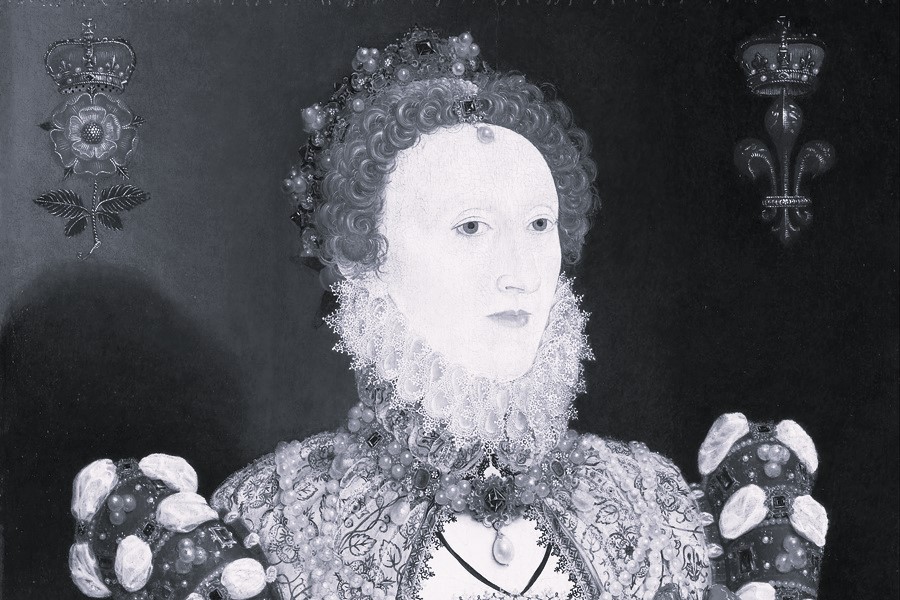When Elizabeth I succeeded to the throne in November 1558, perhaps the most difficult and sensitive problem that she had to address was the question of England’s religion. In the 1530s, Elizabeth’s father Henry VIII had broken with Rome and repudiated the Pope’s jurisdiction within England, but at his death in 1547 much of religious life in English parishes remained quite traditional, albeit without the monasteries and without the Pope. Then Henry’s son Edward VI steered England firmly in a Protestant direction and sought to remove as many traces of Catholicism as possible. However, Edward reigned for only six years (1547-53) and his premature death led to the accession of his devoutly Catholic half-sister Mary I who immediately sought to reintroduce Catholicism. By the time of her death in 1558, Mary had been responsible for the burning of nearly three hundred Protestants as “heretics.”
Current research suggests that in their very different ways both Edward and Mary probably met with enough support to enable their respective religious preferences to settle down if only they had lived long enough. However, tuberculosis claimed Edward at the age of fifteen and cancer claimed Mary at the age of 42, leaving their half-sister Elizabeth to inherit a divided and confused nation. By 1558, there were in England committed minorities of Catholics and Protestants and many in between who were uncertain or who tended to conform to the prevailing policies of whoever happened to occupy the throne.
In Europe at this time, there was a principle, established in the Peace of Augsburg in 1555, that the religion of a state should be that of whoever currently ruled it, an idea summed up in the Latin tag “cuius regio eius religio.” The Church that Elizabeth was responsible for setting up in collaboration with Parliament in 1559 reflected her own moderate form of Protestantism. It was a Church “by law established,” based on the parliamentary Acts of Supremacy and Uniformity. To avoid offending Catholic opinion, Elizabeth became “Supreme Governor” of the Church rather than taking her father’s title of “Supreme Head.” A new Prayer Book was drawn up, based on the second of Edward VI’s two Prayer Books (that of 1552) but with a form of words in the eucharist that combined elements of the Catholic and reformed traditions. Episcopacy survived and the rubric on ornaments allowed for some measure of “popish” ritual.
The result was a church reformed in its doctrine – as set out in the Thirty-Nine Articles of 1563 – but conservative in its structure. It was, as Conrad Russell once put it, a Church that “looked Catholic but sounded Protestant.” This was a broad Church, and like any broad Church it pleased many people but not everybody. Some felt that it was “but halfly reformed” and needed more reform. During the later sixteenth and seventeenth centuries, Puritans called for ‘further reformation’ and demanded that the Church be “purified” of any vestiges of “popery.” Others felt that the conservative elements in the Church, the fact that it had a clerical hierarchy led by bishops, and that it retained a liturgy and some ceremonial in its worship, were a particular strength that made the Church of England distinctively different from other Protestant churches elsewhere in Europe.
The contrast between those two points of view often led to tensions within the Church of England. In the mid-seventeenth century, these issues loomed large among the causes of the English Civil War. Such differences of opinion were, perhaps, the inevitable consequence of Elizabeth I’s wish to create as “comprehensive” – what we would today call “inclusive” – a Church as possible. It was crucially important that Elizabeth I reigned for nearly 45 years: this allowed her religious preferences and her vision of the Church of England to settle down and to become firmly established whereas the visions of Edward VI and Mary I perished with them. For one awful moment, when Elizabeth I contracted smallpox in October 1562, it looked as if a third monarch in succession might die after a short reign of less than ten years. In the event, however, Elizabeth recovered from what turned out to be the only serious of her entire adult life until her final illness in 1603. When she died in March 1603, she was in her seventieth year.
It is intriguing to speculate about what might have happened if either of Elizabeth’s half-siblings had attained such an age. If Edward VI had lived as long as that, he would have been on the throne until 1607, and England might well have had a Church resembling the Protestant parts of Switzerland, Germany or Scandinavia. Conversely, if Mary I had lived as long as Elizabeth I, which would have taken her through to 1586, England might well have remained part of Catholic Europe.
As it was, England ended up with the broad established Church of England that still survives, as the contrast between the Anglo-Catholic (“High Anglican”) and evangelical wings of the Church shows today. Very different people are attracted to the Church of England for very different reasons and they therefore wish to see it evolve in very different directions. Such a diversity of views can be destabilising, as in the debates over female ordination or gay priests, but it can also be a source of strength. The Church of England continues to have all the plusses and minuses of a broad community.
The fact that England ended up with a hybrid Church that treads a middle way between the Catholic and reformed traditions is above all due to the fact that in the second half of the sixteenth century Elizabeth I lived much longer than her two half-siblings. For better or worse, this has meant that it was her vision of the English Church rather than theirs that has endured down to the present day. So the Elizabethan religious settlement of 1559 proved to be a genuinely decisive moment in the history of this country.







